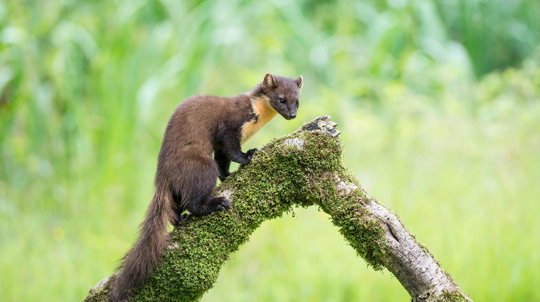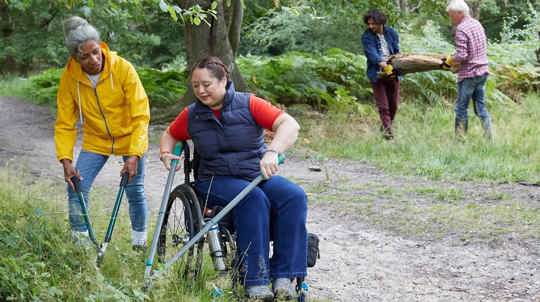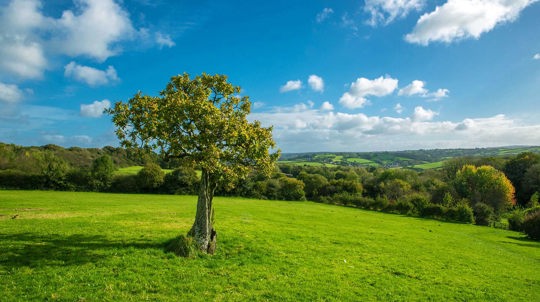Our sustainability strategy
Sustainability is at the core of our work, and our sustainability strategy builds upon a solid foundation of social and environmental responsibility.
Our journey to 2030 is ambitious, focusing on the power that woods and trees play in tackling both the climate and nature crises.
Our approach to sustainability must be aligned to the same climate and nature-positive thinking.
Our vision for a sustainable Woodland Trust
- We will embed sustainable thinking into all decision-making processes – keeping our impact on society and the environment at the forefront of our work at all times.
- We will reduce any material negative impacts within our direct control whilst optimising the positive impact that we deliver.
- We will positively influence suppliers, contractors, partners and policy makers to make sustainable choices.
- We will weave sustainability into the fabric of the organisation by taking accountability for our actions and decisions.
- We will encourage all staff and volunteers to contribute to, and be proud of our progress on sustainability.
- We will use our expertise to lead our sector in sustainable standards of operation.
How we'll manage and report on sustainability
Our responsibility framework will underpin the way we monitor progress on our sustainability strategy. We promise to be:
- transparent, reporting our performance against sustainability indicators on an annual basis, regardless of whether we have achieved or missed targets.
- accountable, identifying and agreeing who'll be responsible for delivering our different sustainability improvements, and setting clear objectives.
- holistic, reporting on a range of areas under social, environmental and governance indicators which encompass our core delivery objectives.
- action-orientated, identifying priority areas for improvement in terms of our impact and influence.
- agile, continually adapting and improving our approach to sustainability, our goals and how we report on our efforts, to ensure we're working as responsibly as possible.
Our sustainability goals
Our detailed plan highlights our sustainability goals, how we'll achieve them and how we'll measure their success.
Our social responsibility goals will be covered in separate people and diversity and inclusion strategies.
Climate action
We want to reduce our carbon emissions as much as possible. We also want to use our influence to help others reduce their carbon emissions.
- We'll use best practice carbon accounting to record the sources, sinks, stocks and flows of carbon within our direct control, as well as important, indirect areas of influence.
- We'll take action to reduce our known direct and indirect emissions, using energy efficient technologies and practices at head office as well as in our ways of working to minimise the impacts of our travel requirements.
- We'll identify key areas where we can use our influence to push for climate positive actions, including in our corporate partnerships, supply chain, investments, and banking and pension providers.
Resource use
We'll transform our business model; investing in our staff, systems and processes to support the transition to more sustainable ways of working.
- We'll lead the sector in finding sustainable alternatives to plastic tree guards. This includes funding and commissioning research into plastic-free methods, stopping using plastic tree guards in our directly controlled activities, and working with landowners and outreach partners to choose sustainable tree protection.
- We'll remove single use plastics across our operations, including marketing and fundraising materials and our shop merchandise.
- We'll continue to ensure that all the timber products we use (on our estate and in our merchandising and licensed products) are FSC® Certified.
Resilient environments
We'll future-proof our operations so we can respond to the changing climate and environment in a way that benefits nature and people.
- We'll identify the risks that climate change poses to our activities and develop actions we can use to overcome or adapt to them. We'll work with other eNGOs to identify the risks a changing climate poses to our sector, and embed climate change adaptation plans into our work plans.
Living systems
We aim to promote – through the nature we care for and our collective expertise – an evidence-based, nature-positive approach to woodland and other habitat management.
- We'll identify sustainable ways to protect woods and trees from competing vegetation. As part of this, we'll continually monitor and minimise our use of pesticides and herbicides using a 'best practice plus' approach that we can continue to improve. We'll also collaborate with other eNGOs to develop a sector-wide approach to pesticide and herbicide reduction and produce guidance on sustainable vegetation control.
- We'll ensure that all the trees we plant are grown in 100% peat-free growing media, and that our procurement chain involves sustainable and bio-secure materials.
- We'll identify key areas of influence where we can promote nature-positive actions both externally and on the ground across our directly controlled estate.
Reporting and engagement
The way we engage with our stakeholders and report our sustainability performance makes us accountable for our actions, and transparently communicates our impact and performance against our objectives.
- We'll be open and transparent about our social and environmental responsibility objectives and how we perform against them.
- We'll establish baseline data against key impact areas and continually monitor and improve our performance against best practice benchmarks.
- We'll embed our sustainability objectives into the workplans of individuals who'll be key to delivering our impact. We'll also establish a network of sustainability champions as part of an internal sustainability advisory group.
- We'll use our sustainability credentials as an advocacy and influencing tool to help deliver our strategic objectives, including fundraising, partnerships and policy.
Sustainable decision making
It's crucial that we factor our social and environmental impacts into key decision-making processes throughout our organisation.
- We'll establish funding and decision-making processes which place sustainability innovation at the heart of how we operate.
- We'll embed systematic processes to ensure we continue to improve the environmental impact of our operations. This will include investing in systems and resources that will help us work more sustainably.
- We'll assess all key strategic decisions according to a sustainability screening process which will apply to procurement, partnerships, retail and more.








